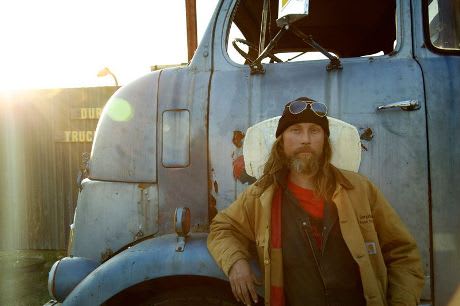In narrative form, Finnish director Aleksi Salmenperä often tackles traditional heteronormative roles and masculinity as an inherently contradictory and ambivalent force. With Producing Adults he deconstructed the nuclear family, detailing Sapphic relationships between a woman and her fertility doctor after her boyfriend secretly gets a vasectomy to avoid parental responsibilities, and in A Man's Work, a husband and father struggles with the demands of social performance as a provider.
As such, it's no surprise that his documentary, Alcan Highway treads similar thematic territory, following Hese, a man living on the social periphery—taking the Peter Pan approach to life—that buys a dilapidated truck in Alaska to drive over 4,000 miles to Vancouver. It's an arbitrary feat and task set ironically within the vacuum of male competition and achievement recognition ethos (even though Hese repeatedly claims to eschew these conventions), but it makes for an intriguing, wholly cinematic, road-trip-as-metaphor story of persistence and futility.
Before Hese can get on the road, he first has to get his truck and miniature mobile home trailer functioning, which takes up a large chunk of the film, considering the vehicle hadn't run for nearly 40 years. These mechanical efforts are largely alienating, circling around the same stubborn disposition and propensity for mercurial outbursts with little development or narrative growth.
Salmenperä smartly keeps the action going, focusing on the progression of the repairs and the minor annoyances in finding the right parts for an older vehicle, but can't compensate for a mostly dull and uninspiring central figure. This is why Alcan Highway fares better once Hese and his team of friends get on the road, encountering breakdowns and even the occasional fire along the way, cooking their dinner on an overheated engine.
Cinematographer Hena Blomberg is able to maximize the landscape and environments during this road trip, adding the element of wide-open landscape expanse to the trajectory of journey versus destination ideology. And since the notion of tackling the wild frontier, relying on the kindness of strangers to get by, isn't particularly groundbreaking—especially in the context of the expansive Canadian environment—this imagery helps keep the moderately compelling story moving forward.
Though Salmenperä succeeds in constructing a genre piece out of a documentary, making reality seem like fiction, the major obstacle here is that of character redundancy. Despite fancying himself vanguard, Hese has very little interesting to say or new to offer in the wake of many weak-willed wanderers before him. And the forced verbal exchanges between him and gas station check-out girls do little to help make him a more appealing and accessible subject.
(Made)As such, it's no surprise that his documentary, Alcan Highway treads similar thematic territory, following Hese, a man living on the social periphery—taking the Peter Pan approach to life—that buys a dilapidated truck in Alaska to drive over 4,000 miles to Vancouver. It's an arbitrary feat and task set ironically within the vacuum of male competition and achievement recognition ethos (even though Hese repeatedly claims to eschew these conventions), but it makes for an intriguing, wholly cinematic, road-trip-as-metaphor story of persistence and futility.
Before Hese can get on the road, he first has to get his truck and miniature mobile home trailer functioning, which takes up a large chunk of the film, considering the vehicle hadn't run for nearly 40 years. These mechanical efforts are largely alienating, circling around the same stubborn disposition and propensity for mercurial outbursts with little development or narrative growth.
Salmenperä smartly keeps the action going, focusing on the progression of the repairs and the minor annoyances in finding the right parts for an older vehicle, but can't compensate for a mostly dull and uninspiring central figure. This is why Alcan Highway fares better once Hese and his team of friends get on the road, encountering breakdowns and even the occasional fire along the way, cooking their dinner on an overheated engine.
Cinematographer Hena Blomberg is able to maximize the landscape and environments during this road trip, adding the element of wide-open landscape expanse to the trajectory of journey versus destination ideology. And since the notion of tackling the wild frontier, relying on the kindness of strangers to get by, isn't particularly groundbreaking—especially in the context of the expansive Canadian environment—this imagery helps keep the moderately compelling story moving forward.
Though Salmenperä succeeds in constructing a genre piece out of a documentary, making reality seem like fiction, the major obstacle here is that of character redundancy. Despite fancying himself vanguard, Hese has very little interesting to say or new to offer in the wake of many weak-willed wanderers before him. And the forced verbal exchanges between him and gas station check-out girls do little to help make him a more appealing and accessible subject.
